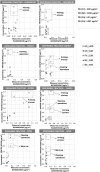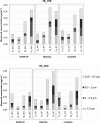Particle measurements of metal additive manufacturing to assess working occupational exposures: a comparative analysis of selective laser melting, laser metal deposition and hybrid laser metal deposition
- PMID: 34719600
- PMCID: PMC9453568
- DOI: 10.2486/indhealth.2021-0114
Particle measurements of metal additive manufacturing to assess working occupational exposures: a comparative analysis of selective laser melting, laser metal deposition and hybrid laser metal deposition
Abstract
This paper presents the results of a measurement campaign for assessing the release of particles and the potential exposure of workers in metal additive manufacturing. The monitoring deals with three environments, i.e., two academic laboratories and one production site, while printing different metallic alloys for chemical composition and size. The monitored devices implement different metal 3D printing processes, named Selective Laser Melting, Laser Metal Deposition and Hybrid Laser Metal Deposition, providing a wide overview of the current laser-based Additive Manufacturing technologies. Despite showing the generation of metal powders during the printing processes, the usual measurements based on gravimetric analysis did not highlight concentrations higher than the international exposure limits for the selected metals (i.e., chromium, cobalt, iron, nickel, and copper). Additional data, collected through a cascade impactor and particle counter coupled with the achievements from previous measurements reported in literature, indicate that during the printing operations, fine and ultrafine metal particles might be generated. Finally, the authors introduced a preliminary characterisation of the particles released during the different phases of the investigated AM processes (powder charging, printing, part cleaning and support removal), highlighting how the different operations may affect the particle size and concentration.
Keywords: Additive manufacturing; Fine particles; Metal particle exposure; Metal particle release; Occupational health.
Figures




References
-
- European Commission (2016) COM/2016/0180 Digitising European Industry Reaping the full benefits of a Digital Single Market.
-
- ISO. ASTM52921–13 (2019) Standard Terminology for Additive Manufacturing - Coordinate Systems and Test Methodologies.
-
- Afshar-Mohajer N, Wu CY, Ladun T, Rajon DA, Huang Y (2015) Characterization of particulate matters and total VOC emissions from a binder jetting 3D printer. Build Environ 93, 293–301.
-
- Davis AY, Zhang Q, Wong J, Weber R, Black M (2019) Characterization of volatile organic compound emissions from consumer level material extrusion 3D printers. Build Environ 160, 106209.

